#historical costuming resources
Text
Minoan Kilt
The large, structural skirt worn by Minoan women in art is instantly recognizable, and when I made my own I combined current best guesses with my own personal tastes.

My kilt shape follows the hypothesis laid out by Bernice Jones in her book Ariadne's Threads: The Construction and Significance of Clothes in the Aegean Bronze Age. She describes the shape of that of a labrys, a double-headed axe with apparent ceremonial significance in Ancient Minoan culture. This garment may be depicted in Linear-B logogram *166 + we, we-being the backwards-s-shaped squiggle in the center which identifies the piece as a garment.

See pages 336 and 341 in Marie-Louise B. Nosch, The Textile Logograms in the Linear B Tablets
Actual details on construction and materials below the cut:
Construction:
The top and bottom edges of the kilt are concave, so the sides are longer than the middle. This gives the chevron-shape seen on layered kilts in art. In addition, the curved top half makes the skirt flare out, accommodating the hips and giving more freedom of movement to the legs. My kilt measured from my waist to my anklebone at the longest point, and about 1.5 times around my waist.
I chose to make a flounced kilt, with smaller strips of fabric and trim applied to a large base piece, rather than a tiered kilt, in which multiple kilt shapes of varying length are layered one on top of the other, so you end up wrangling 3 layers of fabric around the waist. The flounced kilt saves fabric and gives you a lot more freedom with whatever trim you might want. Jones' diagram for a flounced kilt is seen below:

Unlike the version in the diagram above, I chose not to attach ties to the garment itself both because the linen I used was very heavy and I was concerned about weight, and also because folding the skirt and securing it with a separate tie worked just fine for my tastes. In total I had four flounces: 2 alternating rows each of fabric and fringe.
The vertical edges of most kilts are left plain, probably representing either the selvage or an edge otherwise finished off to prevent fraying. For my kilt, however, I ended up with a couple inches of self-fringe on either side as I adjusted the fabric to the correct width. At least three examples of kilts with fringed vertical edges are known, all three from the so-called "House of the Ladies" in Akrotiri
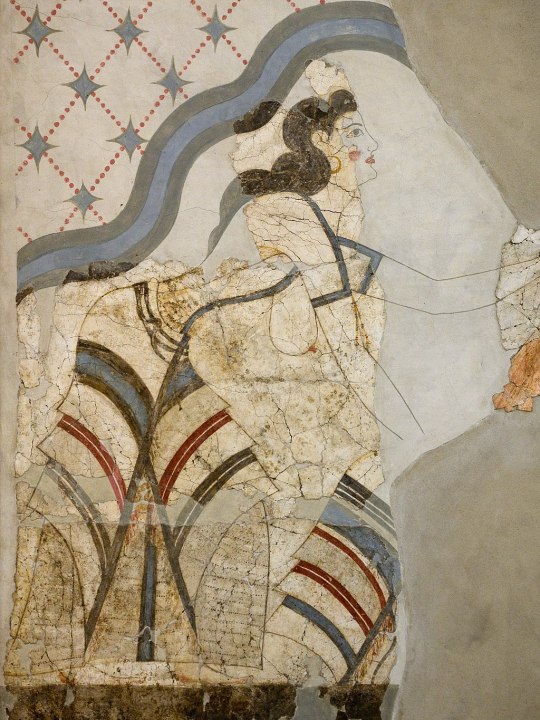

Photos from Wikimedia Commons. Image 1. Image 2.
The vertical edges of these kilts are reinforced with a colored band or tape, probably to keep the garment from unintentional further fraying. Accordingly, I did the same on my kilt. I also like that it gave a nice vertical diagonal to counterbalance the horizontal ones.
Materials
I tried to use mainly linen and wool, the fibers most available on Ancient Crete, but some of my trim was cotton because sometimes you just have to use what's cheap and available in the today times.
The base of my kilt is a heavy, patterned linen in what's called a diaper weave, meaning that a repeating diamond pattern is woven into the pattern itself. A lot of the Minoan textiles depicted in frescoes are characterized by repeating geometric patterns, likely woven into the fabric itself, and that was something I wanted to capture in my own piece. My linen is woven with both cream and natural colored threads. The heavy weight is important to give structure to the garment--otherwise it would be kind of limp. My linen was from Burnley & Trowbridge (shameless plug), as was the plain cotton twill tape I used to bind the top and bottom edges of the kilt, and the dark red wool twill tape I used along the vertical edges.
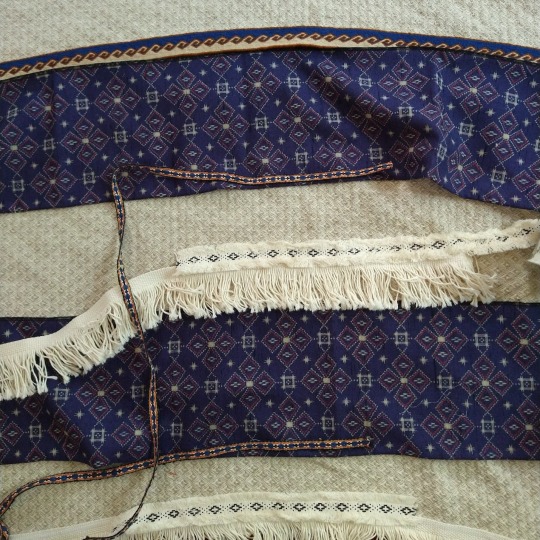
I bought my cotton fringe from a rug supply store. I had to search a while to find a fringe that would work for me, and I ultimately chose fringes with a woven header rather than the more common knotted one, so that it would lay flat against the kilt. I hid the woven header under a layer of cotton fringed trim from Michaels (yes, Michaels) with this really great diamond and dots pattern woven in black.
The blue layers are from a bolt of vintage wool Kimono fabric. Blue appears frequently in frescoes, likely achieved with indigo or woad dye, or even murex/mollusk dye. The fabric is printed with an imitation ikat pattern of diamonds and squares that made me think "the vibes seem right!" because quite frankly, you aren't going to get "historically accurate" Minoan textiles (which there probably isn't enough archaeological evidence to definitively describe) without, like, hand-weaving it yourself or paying someone hundreds of dollars to do it for you (and that price is if the weaver really likes you). Neither of which appealed to my desire to just make a fun, low stress project. Good enough is good enough.
The narrow trim on the bottom of the blue flounces is vintage cotton/poly woven trim. This trim, while narrow, was quite thick and stiff, which was great because it added more weight and structure to the end of my flounces since the wool fabric itself was quite thin.
The top layer is a custom tablet-woven wool trim that I commissioned from MAHTAVAhandicraft on Etsy. I imagined this as the "centerpiece" of my kilt, and I'd arrange everything to complement it.

It's a kivrim pattern, which has itself only been traced to 19th-century Anatolia, but I didn't care. The way it looks like waves reminded me of how central the sea was to life in the Ancient Aegean and Mediterranean and it captured the idea and aesthetic I was pursuing. I mean, doesn't it remind you of these dolphins?

(I like the dolphins)
The whole thing was machine sewn with the exception of hemming and adding trim to the blue flounces. If you were to look at it from the back, you'd see lots of zigzag stitches, because i wanted to be fast! and have fun! not chase some unreachable ideal of "accurate."
As for wearing it, I chose to wear it with the top part folded/rolled down over a belt, so I have a thick tube of fabric around my waist. Many images, like the frescoes above of women with fringed kilts, appear to just show the kilt being tied closed. Other images are so fragmented or stylized that it's unclear what kind of skirt closure was used. Sculptures and figurines definitely show some kind of SOMETHING around the waist, whether this is folded fabric or a kind of belt is unclear. Different art could show different things!
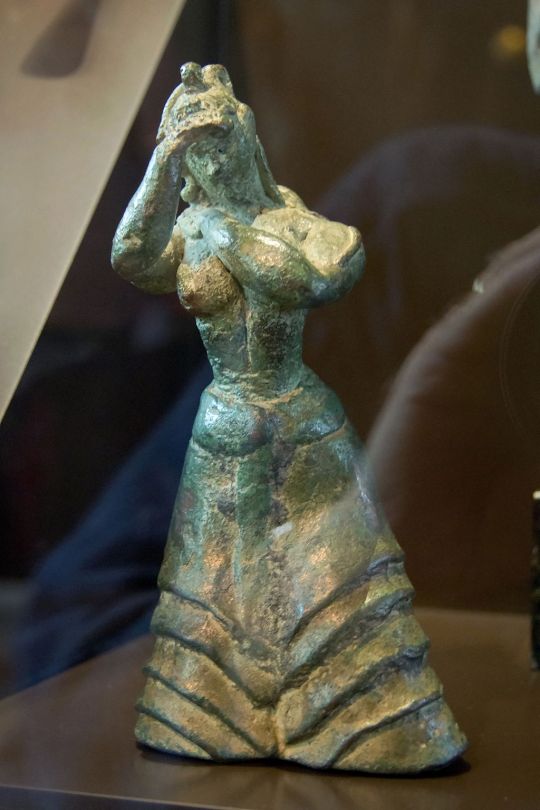
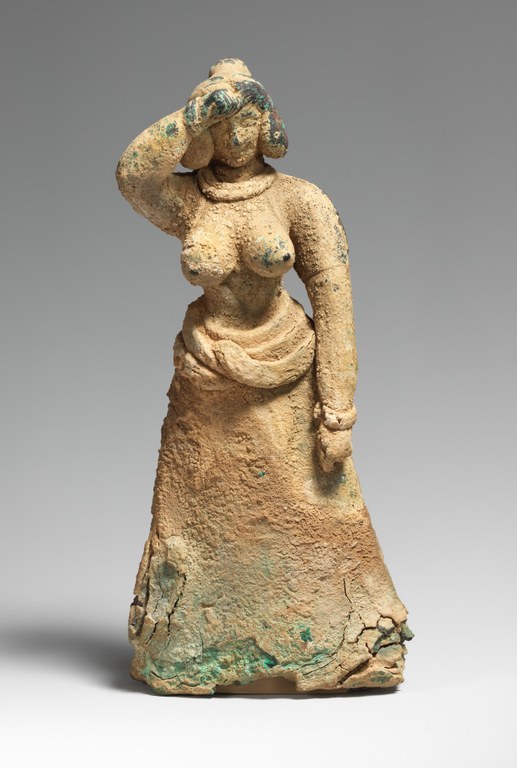
I think I see evidence of a continuous line from the skirt to the waist-roll on the figure on the left, found in Troas, which I think indicates some kind of skirt-folding situation. The woman on the right, found in Crete, looks more like she's wearing some kind of long coiled belt, or perhaps snakes. Who knows? I don't! For my own part, I found the combination of rolled waist + tie belt the most secure for doing things like kneeling, stomping around, and wading into rivers to rescue bees. I also liked that it gave me the bulk around the hips that gives Minoan figurines such a powerful silhouette, and proportionally gives more of an hourglass shape. If you wanted to do something more firmly grounded in the sources, stick just with the waist tie or belt, wrapped around a couple times and tied in back. If you want to be like me, just say "well we don't KNOW it didn't happen" and just do whatever you want. Have fun! Whatever happens, it should be fairly easy to move around in the kilt--this is not a restrictive garment, just a heavy one.
805 notes
·
View notes
Note
Do you have recommendations for dress history youtube channels? I'm a very bookish person, an amateur historian of literature, and i want to understand the practical side of how clothes were made and worn. the pictures in my books only go so far.
Sure! There's some books that also go into the historical construction of clothing, most notably Janet Arnold's Patterns of Fashion series, which is an invaluable resource. Here's my most recommended YouTube channels who do historical costuming and talk about dress history in general:
Nicole Rudolph
Abby Cox
Morgan Donner
Cat's Costumery
Snappy Dragon
Bernadette Banner
priorattire
Adelaine Beeman-White
Karolina Żebrowska
Samantha Bullat
88 notes
·
View notes
Text


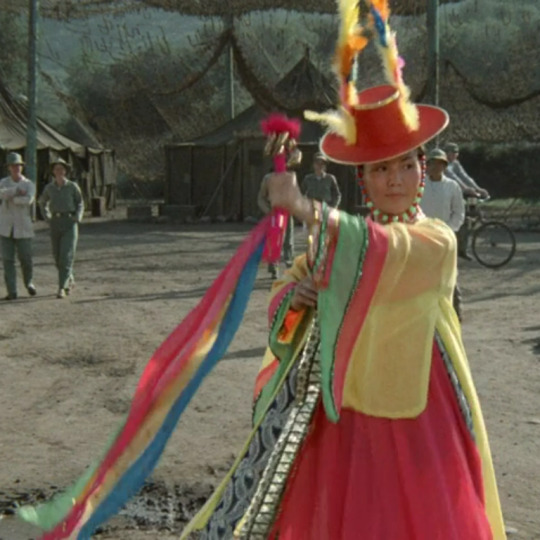

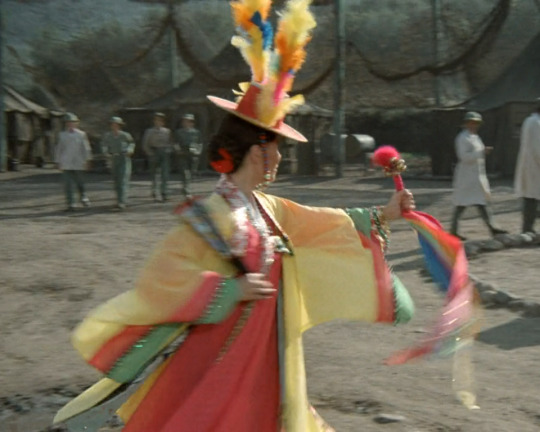
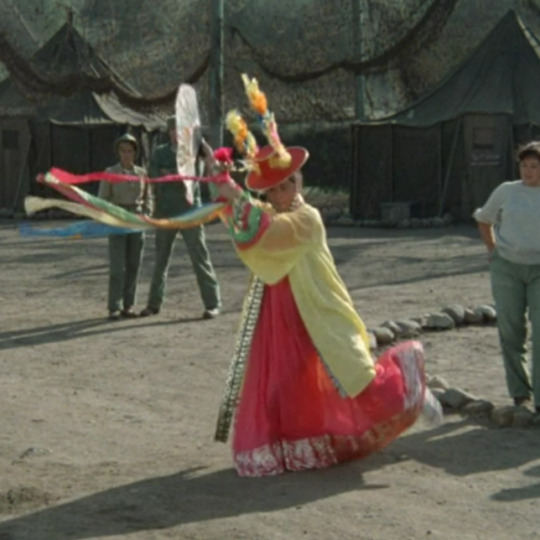
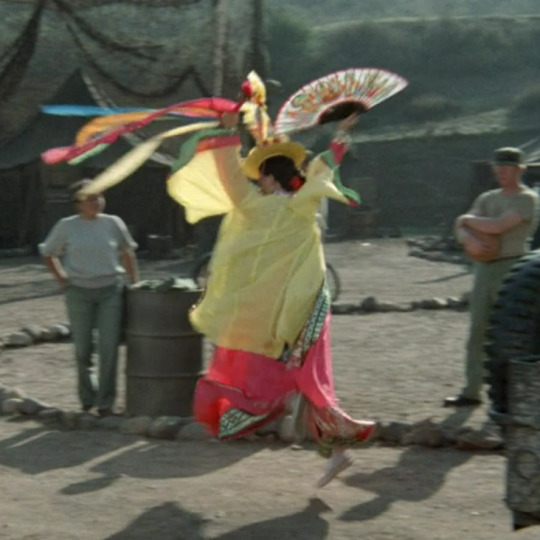

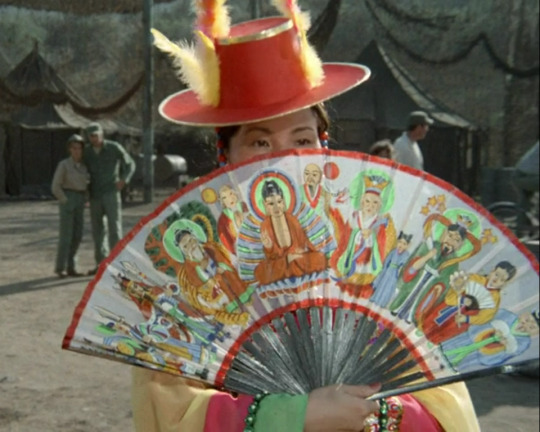

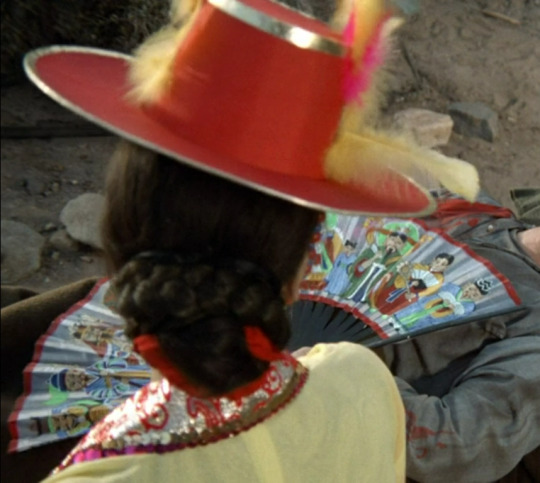
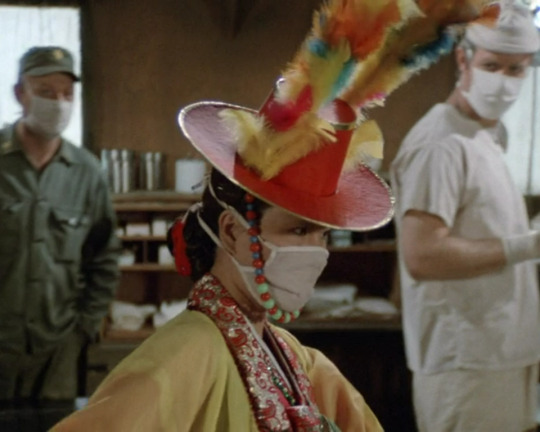
special: korean shaman from season 5 episode 13 "exorcism"
#i couldn't not post this one#her dress is so stunning and i love the way she dances in it#this is one of my favorite episodes for sure#according to mash wiki her clothing and dances are entirely authentic#i don't have the knowledge to confirm that but i love how respectful the episode feel towards the natives and their tradition#i love how the scene with her dancing goes on for so long and really lets it breathe#such a beautiful scene <3#by the way if anyone has resources (online/literature/whatever) about the local clothing and tradition i'd be excited about anything!#will forever hate that our historical costuming classes only cover europe#have a great day everybody#mash#m*a*s*h#klingerfashionarchive#mashblr
28 notes
·
View notes
Text
can anyone suggest any good resources for historial fashion?
update: thanks everyone <3 super helpful
#specifically looking for stuff in the 1860s-1880s range#though currently all my historical costuming books are back in the uk so it'd be great to have some online resources in general#i know in my heart that the gay people in my phone won't let me down
30 notes
·
View notes
Text

The resolution isn't the best, but to the left is my ear, wearing my favourite pair of antique earrings, and to the left that of a lady of the early 18th century wearing earrings of a very similar design.
I was quite surprised to happen across earrings very much like mine in a painting, despite having seen photos of other currently extant pairs that look very similar online.
Perhaps it is the fact that she selected these exact earrings to be represented in her portrait, similar to me deciding that I wanted my picture taken wearing mine.
#i mainly buy antique jewellery bc they don't require new resources to be produced and bc they're of a more durable quality#even the costume jewellery of the 1910s will last longer than the costume jewellery of today#r rambles#historical jewelry#antique jewellery#18th century#18th century fashion#fashion history
21 notes
·
View notes
Text
The MET has a costume institute with a lot of stuff from the 15th century onward AND it's got an online archive with pictures you can look at for free!!! Granted it's all on mannequins but it's all authentic pieces. There aren't a lot of stuff from the Middle East or Africa, so if I find a good resource for those I'll post it too, but I found this and thought you friends might like to know about it too.
10 notes
·
View notes
Text
Floofy Shirt Sew-along: Step 2 - Gussets and Shoulders

This project starts with the most baffling part, the gussets. Not a thing used overmuch in day clothes. We’re gonna make it work though!
Morgan Donner’s gusset video explains the basic principle of underarm gussets really well. The explanation how to sew the point neatly is particularly useful for our neck gussets.
Take up your two shoulder pieces and two of your 8x8 gussets. You want them to end up looking like this:
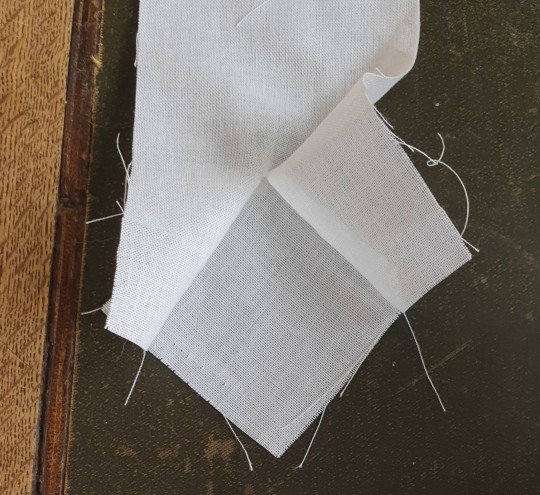
Make a 6 cm long slit in each shoulder piece, like so:

Put one of your shoulder gusset squares under your folded shoulder piece so one point matches up with the end of your cut shoulder slit. Pin and sew.
Fold over the edges of the slit you just cut and lay it out so the newly open space forms a triangle.
Edit: I made a little video to demonstrate this!
Repeat for the second one.
The free triangle of the gusset is going to be inserted in the shoulder slit and the shoulder piece folded over to enforce the whole shoulder bit.
These are small pieces that will take a lot of strain, so I use backstitches. For people just starting out, this Bernadette Banner video on basic handsewing stitches is a good visual explanation of what the different stitches do.
Onto the body!
Fold the body in half (or one side 8cm longer if you want to be historical)
This fold is the shoulderline, mark it and find the middle of this line, this is where the slit down the front will go. Cut this slit downwards 16 cm (you can go lower if you want to be particularly barechested of course)
Your shoulder gusset pieces need to go in those shoulder slits and then folded over so they end up on top of the shoulder and the gusset seam allowances are neatly closed in. (I’m going to be posting pictures of each step of this as I do this.) You’re going to want to end up like this:
On the shoulder line, cut about 30 cms to each side (about 10cm should be left). Now your head should be able to go through.

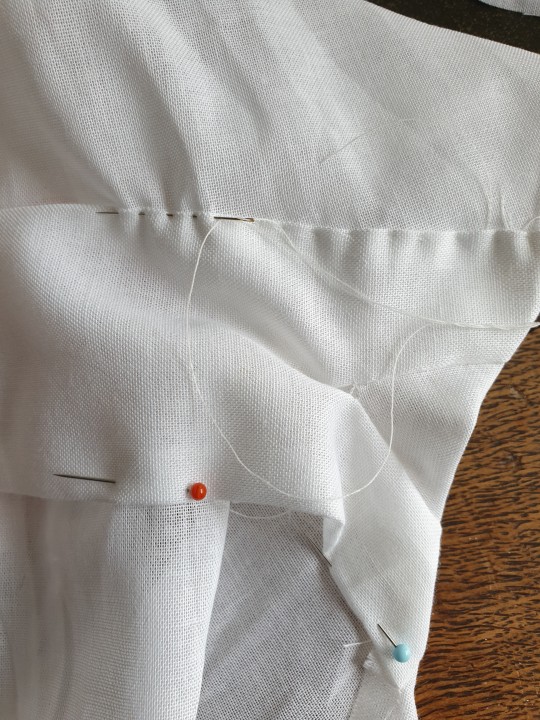
Turn the edges of the shoulder piece under and sew them onto the body like in the picture above. The end that faces the shoulder seam can be left messy, they’ll disappear into the sleeves.
Tl:dr – insert your shoulder gussets in the shoulder pieces. Cut the neck and shoulder slits in the body. Insert the free gusset triangle in the shoulder piece, raw seams facing out, sew and flip over so the right sight of the shoulder piece covers the body like an epaulet with raw edges hidden. Sew down.
#floofy shirt sewalong#floofy shirt sewalong instructions#historical costuming#sewing resources#a talia original#this may be a two week step we'll see#i'm gonna do a separate post on the gusset into shoulder piece bit because it's much simpler when you see it done#it is imperative you stick your head through and flap around after you've cut the neck slit
54 notes
·
View notes
Note
I’m so sorry if you’ve already answered this somewhere, but how do you design your characters?
I’ve been trying to make an OC from the prohibition era and it turns out there’s basically nothing to work with for men’s outfits, so I’m curious how you made this many that look unique and fitting to the characters
There is so much to work with, though!
You will tend to find more of a focus on variety in women's fashion, but there is still quite a lot of menswear to ogle too.
I suppose it's just a matter of searching out ideas and inspiration in the rights corners. Here are a few suggestions:
Old Clothing Catalogues -
Collections from Sears-Roebuck and other popular clothing retailers are pretty easy to find compiled into relatively inexpensive books, or just floating online.
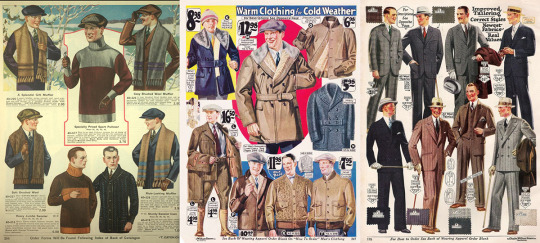
A fair bit of it is in the public domain now.
--Here's an entire 1922 catalogue of stuff to flip through.
-----------------
Contemporary Artwork -
Some phenomenal illustrators were working in this field amidst the "Golden Age of Illustration" and featured prominently on the covers of magazines and on the ads inside. There was a lot of emphasis on fashion.

Collier's and The Saturday Evening Post are a couple of the more prominent and easily searchable resources. The costuming on the cover art always has a lot of personality.
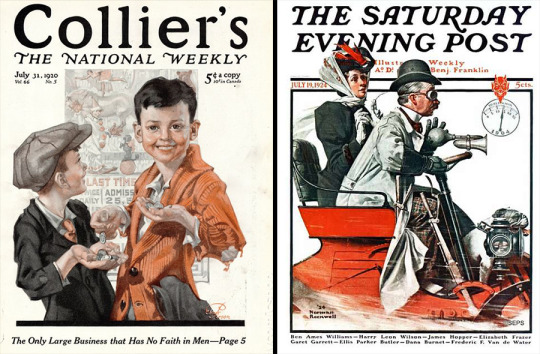
There's Rockwell, of course, and it's almost impossible to go wrong with J. C. Leyendecker. He's probably best known for his Arrow Collar ad art, but even his sock ads are like…
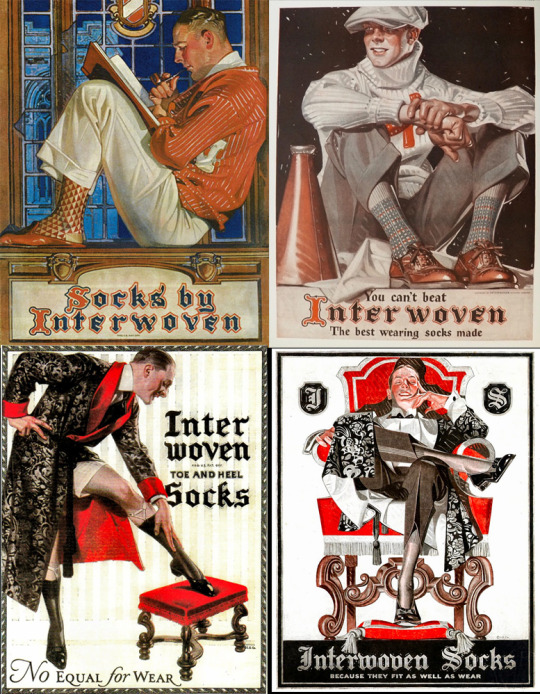
There were numerous other amazing and influential illustrators working at the time too. Here's a list of some of them.
Here's a bonus Henry Raleigh featuring some of his fabulously-dressed people.
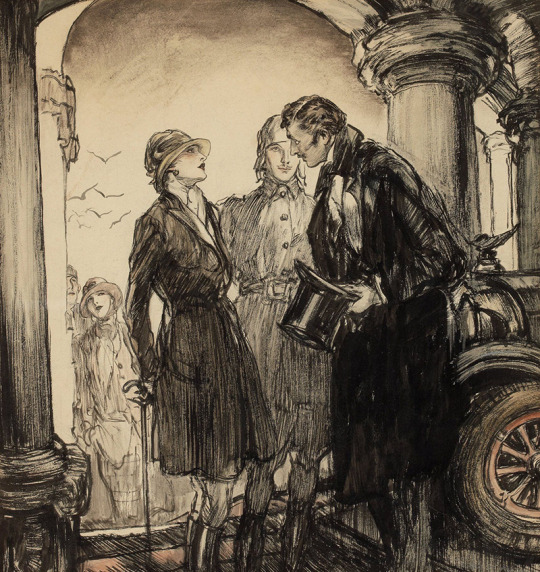
-----------------
Blogs and Articles -
There are so many of them!
If you want historical accuracy, be wary of write-ups pulling all of their references from film and television. There's nothing wrong with using those for inspiration if you aren't too concerned with historicity, but there are some pretty comprehensive and well-researched things out there with more of an eye on actual fashion history too:
--Gentleman's Gazette - What Men Really Wore in the 1920s
--The Fashionisto - 1920s Men's Fashion
-----------------
Digital Collections -
There are numerous digital historic image collections stemming from universities, museums, libraries, and the government that are free to peruse too.
--The Metropolitan Museum has a searchable catalog of exhibits that includes fashion and photos
--Here's some things from the New York Public Library
-----------------
Photos at Large -
If you aren't sure where to start, image searching for any of Hollywood's early celebrities will typically turn up a bevy of production stills and promotional photography featuring a variety of fashions.
Here's a random Getty images search for Harold Lloyd. A lot of standard 3 piece suits, but a lot of stuff with added character too.
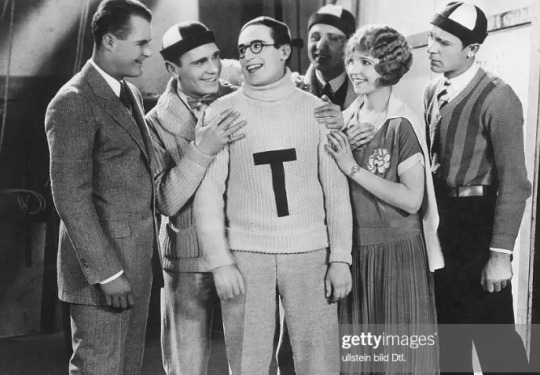
Photography was generally quite accessible by the 1920s, though, and you can find a lot of authentic photos of people from all walks of life, out in the wild wearing all sorts of clothes.
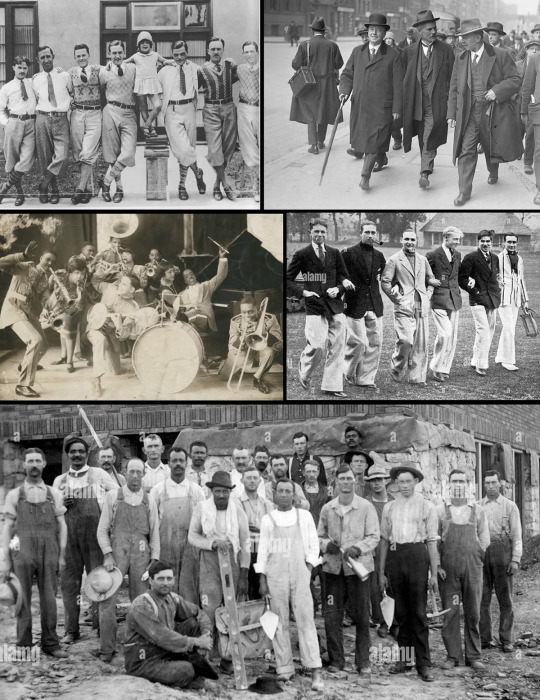
This is by no means the limit to the resources available, but hopefully it'll provide some leaping-off points for designing looks for your characters!
3K notes
·
View notes
Text


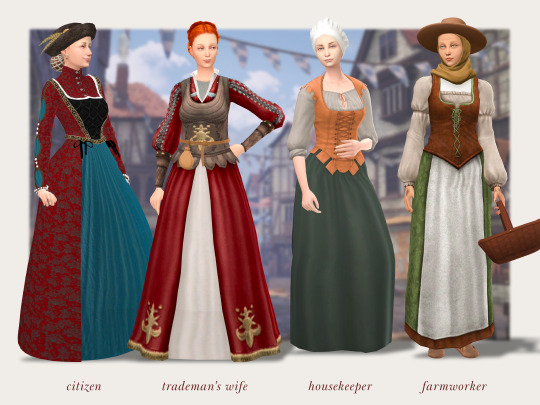
While I absolutely adore all historical costume, the Tudor era has to be one of my all time favourites. The luxurious textiles, the rich colours, the opulent details - it's truly heaven for a costume nerd like myself. Tudor fashion was heavily influenced by key figures in the royal court such as Catherine of Aragon and Anne Boleyn. Wealthier aristocratic women would demonstrate their status through their striking silhouettes, highly-embellished outer layers and ostentatious headdresses. While the clothing of lower classes remained much more simple than the upper class, the newly fashionable silhouette still trickled down through social strata.
You can find more of my historical content here: 1300s ✺ 1400s ✺ 1500s ✺ 1600s
OUTFIT RESOURCES
Queen: Hair | Crown | Circlet | Earrings (TSR) | Ruff | Dress | Cloak
Princess: Hair | French Hood | Earrings (TSR) | Necklace | Dress | Undershirt | Ring (TSR)
Noblewoman One: Hair | Earrings | Ruff | Dress | Necklace | Undershirt | Fan
Noblewoman Two: Hair | Earrings (TSR) | Dress | Undershirt | Necklace | Ring
Lady One: Gable Hood | Necklace | Dress | Undershirt | Right Ring (TSR) | Left Ring (TSR)
Lady Two: Headpiece | Hair (TSR) | Earrings | Ruff | Necklace | Dress | Ring (TSR)
Patrician: Hat (TSR) | Hair (TSR) | Earrings | Ruff | Necklace | Dress | Gloves
Merchant's Wife: Hat | Hair | Earrings (TSR) | Dress | Cuffs | Ring One (TSR) | Ring Two
Citizen: Hat | Hair | Earrings (TSR) | Dress
Trademan's Wife: Hair | Dress | Belt (TSR)
Housekeeper: Head Covering | Outfit
Farmworker: Hat | Wimple | Outfit | Basket | Shoes (TSR)
With thanks to some amazing creators: @leeleesims1 @thesimpireblr @the-melancholy-maiden @strangestorytellersims @elfdor @glitterberrysims @plazasims @natalia-auditore @miikocc @teanmoon @simsregalia @waxesnostalgic @simverses @ms-marysims @simulatedstyles @batsfromwesteros @shoelala-sims @tzuhu @zx-ta @lady-moriel @dancemachinetrait @historicalsimslife @pralinesims @rustys-cc @simstomaggie @sims4nexus @zurkdesign @pea-milk @plumbobteasociety
#ts4#ts4 cc cas#the sims 4#ts4 decades challenge#sims 4 decades challenge#ts4 cc#ts4 historical#ts4 history challenge#sims 4 history challenge#sims 4 historical#1500s#16th century#ultimate decades challenge#ts4 lookbook#sims 4 lookbook#lookbook#tudor#renaissance#historical lookbook
358 notes
·
View notes
Text
Minoan Heanos
The distinctive open-front dresses worn by Minoan women are probably even more iconic than the multi-layered kilts. Over time, there's dispute whether the garment is one piece or a separate bodice and skirt, but currently the one-piece theory is in ascendance.

The word heanos is derived from the Linear B logogram *146, wehanos. The wes- prefix, which is the squiggle in the middle, indicates a garment. Bernice Jones believes that this logogram represents the garment worn by Minoan men and women.
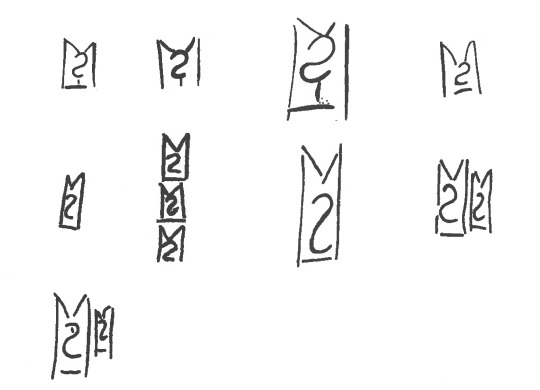
Marie-Louise B. Nosch, The Textile Logograms in the Linear B Tablets, pp 133-138
More research and construction below the cut:
The theory that the garment is a full-length tunic is further supported from imagery from the time, like these figures from the c. 1400 BCE Hagia Triada Sarcophagus. This detail from the sarcophagus shows three figures in some kind of procession, 2 women and 1 man. The woman at left wears a tunic with some kind of pelt as a skirt, and the other 2 figures wear tunics without anything over them, showing that they are one continuous, ankle-length garment.
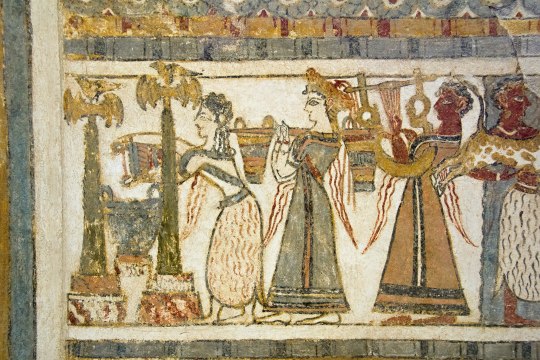
Some of the most important resources for interpreting how the heanos was constructed comes from the two women depicted in the House of the Ladies in Akrotiri, wherein the side seams of the tunic are clearly visible running along the side of the body and under the arm.
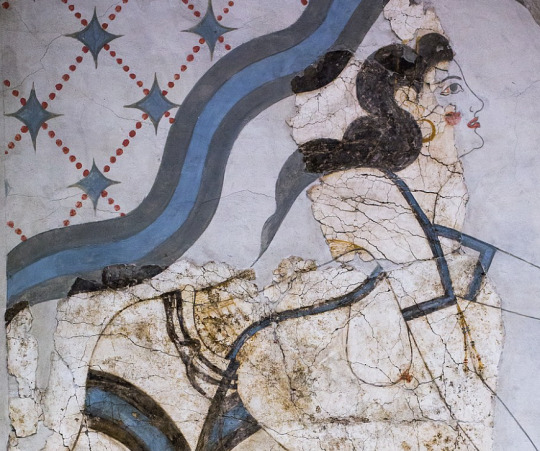
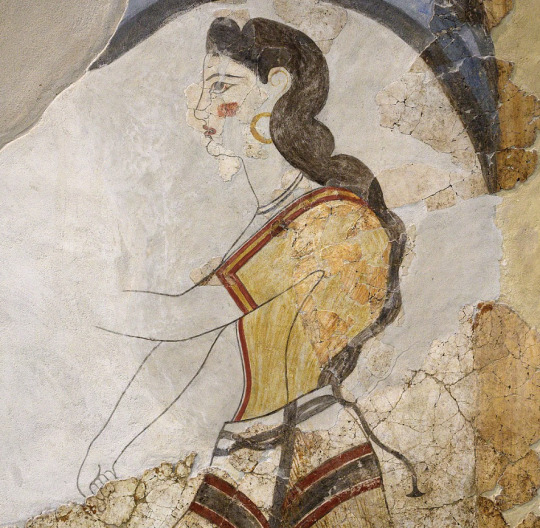
details of figures from the House of the Ladies, Akrotiri, via Wikimedia Commons
advadbsvasb
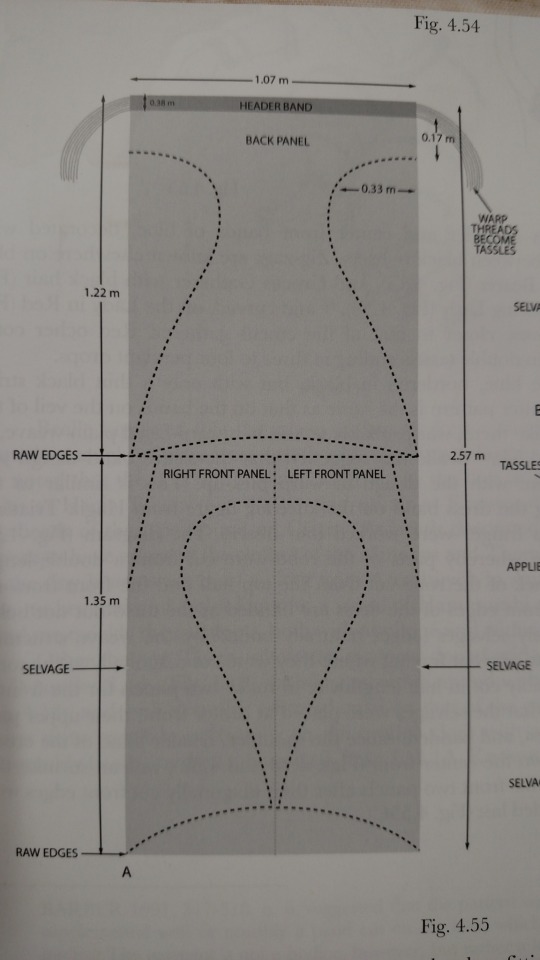

Diagrams from Bernice Jones' book Ariadne's Threads, p. 82, via Gorgeous Tangents
The heanos itself is made of 3 pieces of fabric: 1 back and 2 fronts. These diagrams show a concave hem like on the labrys-shaped kilt but I went with a straight hem, which is an equally valid option. The end of the sleeves are level with the edge of the hem at the widest point. This would probably be the width selvage-to-selvage on the fabric, being narrower than fabric widths commonly are today. There are 4 seams: the shoulder seam, the two side seams, and a front seam (optional, but recommended if you would prefer not being arrested.) It may be tempting to fold the fabric across the shoulder, so the only sewing is side seams and a neck hole, but this makes a weaker garment overall. I used this as a shortcut in my fitting muslin and it caused tears and weak points at the three points of the front opening.

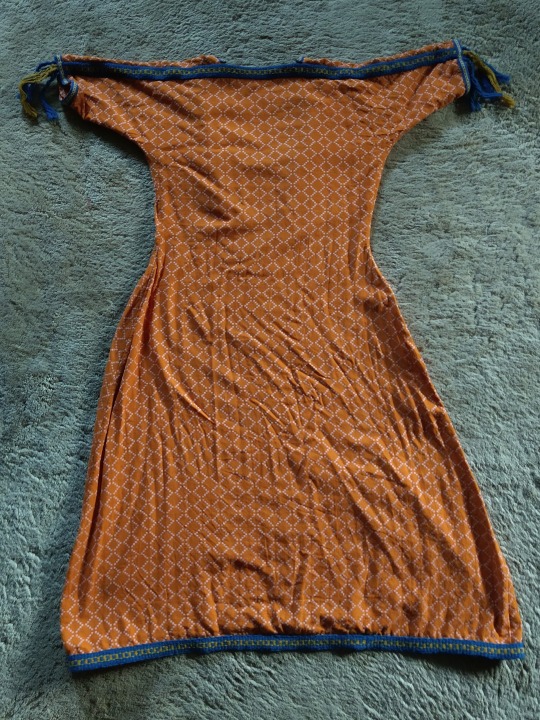
my fabric was a lightweight, moderately loose-woven cotton with a supplementary weave pattern in squares and diamonds. Linen or wool would have been more accurate but also? much harder to find from online quilting stores selling fabric for affordable prices. The main fabric is dark orange and the pattern is made out of pink/lilac threads. This weaving technique resulted in a LOT of long floats (unsecured expenses of thread) on the back--you can see how the wrong side of the fabric is much pinker than the right side. These floats could snag easily if I wasn't careful, so while it made a very effective visual for this tunic, I do not think that this fabric type would be viable for everyday wear. I'll leave it to people who actually know about weaving to ponder what more accurate weaving techniques would be.
Construction
The overall pattern is basically a T-shaped tunic, and the most important measurements are shoulder circumference, shoulder width, bust circumference, and the shoulder-waist length. In addition, you need measurements for the bicep, waist, shoulder-navel length, and hip circumference. After working out the fit with a muslin, I ended up with this pattern, 1 of 4 identical quarters.

Your first impulse may be to make the tunic very close-fitting, since the depictions in frescoes are skin-tight, but since the pattern has no added gusset this is a recipe for Cannot Move Arm. So I gave a very generous curve under the arm, which also made the dress look better when my arms were down, avoiding armpit wrinkles. I continued that ease into about an extra 2 inches added on to my waist measurement and plenty of extra space around my hips so that I could do exciting things like Sit Down.


I sewed the shoulder and side seams using the machine, and felled the raw edges on each side of the seam by hand with a whipstitch. I foided back the front edges of the v-neck instead of cutting them, which was a tip I got from the Gorgeous Tangents blog. This strengthens the neckline and keeps it from stretching, and also means that everything can be readjusted if you have size fluctuations or just want to modify the tunic into something more or less modest.
I whipstitched the front edges together by hand--the contrasting selvage didn't matter because it would be covered up by trim. I ended up cutting the tunic a liiiittle shorter than I wanted, so I finished it with some leftover bias binding instead of hemming it to conserve as much length as possible.
Trim

I custom-ordered the woven tape trim from Long Creek Mercantile. Both are made of wool--the "header band" and the hem trim are 1 1/4" wide and the center-front and cuff trim are 3/8" wide. I observed that most images of the Minoan heanos show trim with two colors at most, in a simple geometric or linear pattern, so I consciously restrained myself from ordering anything more elaborate. The clothing on Minoan frescoes is characterized by strongly contrasting colors, so blue trim was the most obvious, and best-looking option. Orange tunics with blue trim appear multiple time in art like the "Dancing Lady" fresco from Knossos:

Dr. Jones suggests that the band across the shoulder would historically have been a header band--a band of threads woven at the beginning of a project in order to properly space the warp bands (see her diagram at the beginning). That may be a reason why the shoulder trim often depicted under the front or sleeve trim, as shown above. Regardless, the trim almost always coordinates.
I sewed on the shoulder trim by hand, the sleeve and hem trim by machine, and the center-front trim with a combination of both.
Tassels
Many frescoes from Akrotiri and Hagia Triada show the ends of the supposed header band turned into tassels. This embellishment is not universal among heanoi, as you can see from the "Dancing Lady" above, but it does add a fun little something!

(yes, my Lounging Pants are very fashionable)
I turned the excess ends of the shoulder "header band" trim into fringes, knotting the yellow ones into a lattice and turning the blue yarns into tassels. The lattice-tassel appears on a fresco from Hagia Triada:

Reproduction of fragmentary fresco from Room 14 at Hagia Triada, Crete
The saffron gatherers from Akrotiri shown below have clearly displayed fringes at the ends of their sleeves. The one on the left has red fringes that appear knotted or ravelled/unravelled in an undulating pattern, and the one on the right has fringes that may be either beaded with papyrus-shaped leaves or cut into short tassels.
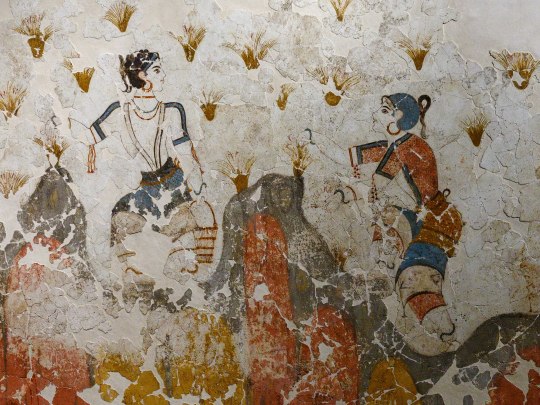
Another option is leaving the fringes loose, as seen in the Akrotiri frescoes from Xeste, room 3:
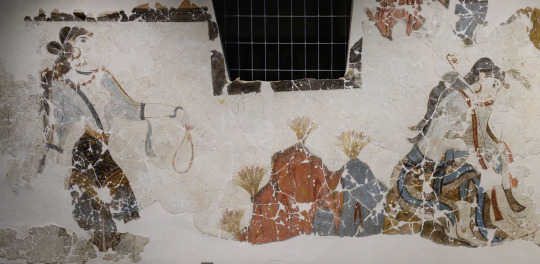
The final garment was super comfy, actually! It's much simpler to create than I thought it would be based on the frescoes, which made it all feel pretty magical when everything came together. I did think it was a little unusual how tailored this garment is, and the potential waste of fabric that comes from a shaped garment, especially compared to how later ancient greek clothing was mainly rectangles. I don't know enough about bronze-age and earlier clothing to have any idea how typical this was, since I'm extremely Not an expert on this subject, but am always open to learning more!
477 notes
·
View notes
Text
Dress History Corner Navigation
Welcome to the corner of the interned where I nerd about (mostly) Western dress history! This is the post I will update with all my more structured and researched articles. I have the same navigation on my blog, but it's only for the browser so I figured it would be useful to have navigation that work for the app too.
Some basics
An Introductory Timeline Of Western Women's Fashion
How I do my research into dress history
Dress History
Lacing in Western Fashion History
Dress Etiquette Thorough Western History
When Did It Become Acceptable For Western Women To Wear Pants?
When Did Skirts Stop Being Acceptable For Western Men To Wear?
Is Lingerie Going Backwards - A Rebuttal
The history of showing your boobs for fashion
Victorian Era
A summary of different kinds of corsets
Historical Finnish Clothing of Modern Period
Victorian Dress For Every Occasion - 1890s Edition
1890s Day Dresses
American Civil War era (1861-65) ball gown
Regency
Debunking the common narrative about Beau Brummel - The whole modern men's fashion is not the fault of One Guy
Gender non-conforming Regency styles
18th century
The Colonial History of How Cotton Became the Most Important Fabric
Mantua And It's Variants
Northern Italian countryside fashion in late 18th century.
Working Class Clothing In Late 18th Century France
Early Modern Era
Deep Dive into 15th and 16th Century Working Class Fashion in Western Europe
Medieval Era
Late 14th to Early 15th Century Bohemian and German Men's Fashion
Construction of Men's Hose
Codpiece
Construction of the French hood
Iron Age
Viking and Crusader Age Finnish men's dress
Historical Sewing
Sewing Medieval Bathhouse Dress
Historical Costuming
History of the Fantasy Corset
Met Gala 2022 Costume Commentary
Pride and Prejudice 2005 Costume Analysis
Ranking Men's Costumes in Renaissance Period Dramas - Part I: The Bad
Ranking Men's Costumes in Renaissance Period Dramas - Part II: The Good
Textiles
Hemp's properties
Sustainability
How to see through the greenwashing propaganda of the fashion industry - Case study 1: Shein
The Real Cost of the Fashion Industry
Architectural History
History of Sauna and Steam Baths
Historical Queer Figures
Julie d'Aubigny
History
Palestinian History Between Great Powers
European History Is Not White
Tag Navigation
#answers
#resources
Primary sources
#primary sources
#extant garment
#photograph
#painting
#illustration
#fashion plate
Pinterest Boards
Victorian Fashion
#i actually don't currently have the exact same navigation on the blog but i will once i get around updating it lol#fashion history#dress history#history#historical sewing#historical costuming#textiles#textile history#architectural history#architecture#historical resources#navigation#nav
211 notes
·
View notes
Text
Fashion history resources?
researching fashion for the various time periods has been driving me a little crazy, particularly because when you search up historical fashion, the results overwhelmingly trend towards upper class women (usually aristocracy), then upper class/aristocratic men, then middle class men/women, with little representation of working class women and even less for working class men. (This obviously depends on time period and country; currently, I'm scrounging around for references for servants in 1660s France. Non-European fashion is even harder to research).
So, I figured it could be good to start a chain of resources on fashion history! Here's two that I've been using heavily in researching my current WIP:
Nicole Kipar's Restoration Costume Comes to Life
This truly lovely website which details costumes of the Restoration (1660s England, mostly), and has a gallery collection of paintings of working class people with annotations on what they're wearing, the time period, and their specific social role (i.e., poor peasant, affluent peasant, market trader). It's designed for costume makers, but it's also useful for artists or writers. There are five parts: working class men and women, women of the gentry and aristocracy, men of the gentry and aristocracy, accessories, and a costume focus.
Fashion History Timeline
It is what the name suggests: open source fashion history timeline from prehistory to (afaik) 19th century. I haven't explored much beyond 1660s yet, and generally does seem to focus on fashion of the upper classes, but it's already been so useful.
If anyone has any websites/books/other resources to add, please do!
956 notes
·
View notes
Note
Do you have any suggestions on where to purchase vintage/reproduction/historically inspired menswear? This is often the first question I get when people find out I went to school for costume design, at which point I am forced to explain that my training... really does not cover that. At all. The shops I'm aware of make either costumes, or exclusively women's clothing, which seems rather unfair.
I'm tempted to just make some, but my program taught exclusively design and no construction. The end result is that I know exactly how a garment is made in theory, but in reality I'm still figuring out waistbands and closures.
I'm afraid I haven't a clue! I don't really buy clothes, aside from socks, shoes, and underwear. But I'll post this and maybe some of my followers will have suggestions.
It sucks that your program didn't teach sewing :( It's so important to have experience putting things together when you have to design those things.
(If you do want to make some, here's an obligatory link to my 18th century menswear resources post.)
177 notes
·
View notes
Note
heya! I'm wondering, from where do you reference clothing for your art pieces? (Specifically for Inver!) I enjoy the outfits you draw your characters in
hii so for the fancier victorian-era outfits i used a whole bunch of sources but among them the metropolitan museum costume collection, this is a great online gallery of historical costume that you can search by era. you can also find illustrated fashion plates from the era to get a sense of how people styled the outfits, facial hair, accessories etc. here's one for hats i used. i also followed the twitter account WikiVictorian which.. due to new twitter policies you can't view accounts while not logged in, but it looks like they have a pinterest and also instagram?? anyway great resource, posted a lot of dresses, furniture, and historical recipes with sources & context.
(cut for length)
but those dresses and stuff are for the upper classes. For ordinary people i just googled what I knew every old lady wears: shawls

this is a galway shawl which is like. THE thing every single person wore back in the day and if you check out the wiki page it's a great reference for what patterns & dyes would have been used. from there you can find historical photos. i love photos like this which show a whole scene in context with people from multiple generations hanging out (yooo check out the Sparch in the background!!). now I know this isn't 1860s stuff, but the fact is that fashion doesn't move so fast for people like Clarion who live on a farm and have to make their simple clothing items last for a lifetime or more.
for the military outfits I mainly just googled 'military outfit 1860s' and iterated (groundbreaking). for things to be accurate i tried to pick reference illustrations drawn during the era.
i figure you might mean specifically the ancient Inver stuff so for them I used a lot of old illustrations and stuff from art history class in school. this era is more in the region of the 1500s. here is a kind of kitchy site which nonetheless has real-life examples of some of the clothing i drew. this painting is in my list of references (sorry for the stock image link but it's one of the nicest online reproductions of it) and you can see the guys on the right wearing the same léine that i've drawn Finbarr in. once you know the time period & what the various outfit components are called you can search them more easily. now the headdress i've drawn Finbarr wearing (Olivier wears it as well!) is in fact a real thing, it's the Petrie crown broken in half.
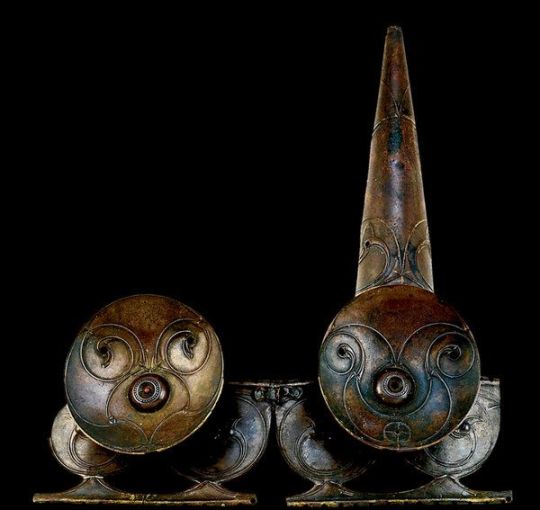
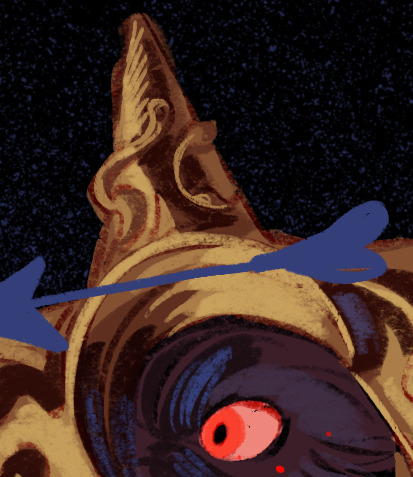
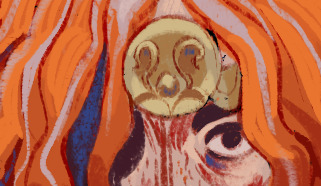
the crown is not of the same era as the other outfits because i'm not so interested in historical accuracy as much for these guys (booo).
for Olivier I searched for old French armour from the same historic era as Finbarr, I know less about the history of Brittany so kind of just copied what I saw with some small alterations (because he wears werewolf armour, which is not a thing irl).
#setting: inver#i know there's a website for renting costumes that goes around every so often on tumblr but i find them really lacking in menswear usually
207 notes
·
View notes
Note
Good sir, I am hoping to pick your brain. I’m making an 18-century (“pirate”) shirt as a gift to my friend. He wants tie closures on the neck and cuffs instead of buttons. Might you have any insight or resources for this? I’ve seen the ties in at least one of the extant shirts I’ve viewed online. I’m still pretty new to the sewing gig and I’d like to minimize inventing metaphorical wheel as much as possible. Thanks in advance!
It's very unusual, but do know of one example! (Not that extant one though)
But first - Link to my most thorough shirt construction blog post. (It's a few years old and I've improved a few little things in my technique since then, and I mean to finish writing a new and better one before the year is over.)
Ok, ties on shirts!
I'm assuming this is the extant one you're talking about? Tbh I'd discount this one entirely if you're looking for information on 18th century men's shirts because I don't think it is one.

Besides the attached ties, the sleeves are extremely weird. They're cut off and have no wristbands!! This would make it quite impossible to wear under a coat, the wristbands are an absolutely essential part of an 18th century shirt.
I also don't see any reason to believe this is actually 18th century when it could just as easily be 19th century, and considering how short the slit is I think that more likely.
(Lots of auction sellers like to say "late 18th century" about things that are like... yeahh maaaaybe that's plausibly from a very fashion forward guy in the late 1790's but it's much more likely early 19th century. And with court dress they sometimes just straight up date it several decades too early. Look at lots of examples and always question everything, because museums don't always date things correctly either.)
I think I remember seeing someone mention once that it was a 19th century workman's garment of some sort, but I can't remember where, and all we've got to go on are a few pictures and a brief caption from a seller who doesn't know what they're talking about. It does look like it could have been worn over another layer though, and the fabric is very coarse. It could also have been altered at a later date for theatrical costume, which is something the Victorians did to A LOT of 18th century garments.
So just ignore that shirt!
The vast majority of 18th century mens shirts close with 2 or 3 buttons on the collar, but there is a style that uses ribbons. It appears to have been fairly common in the late 17th and early 18th century, and then slowly dwindles as the century goes on. I have a section for it on my shirts pinterest board with 64 examples. Ooh, wait, 65, just found a new one.
The collar is made with little to no overlap and one buttonhole on each end, and a ribbon is threaded through them.
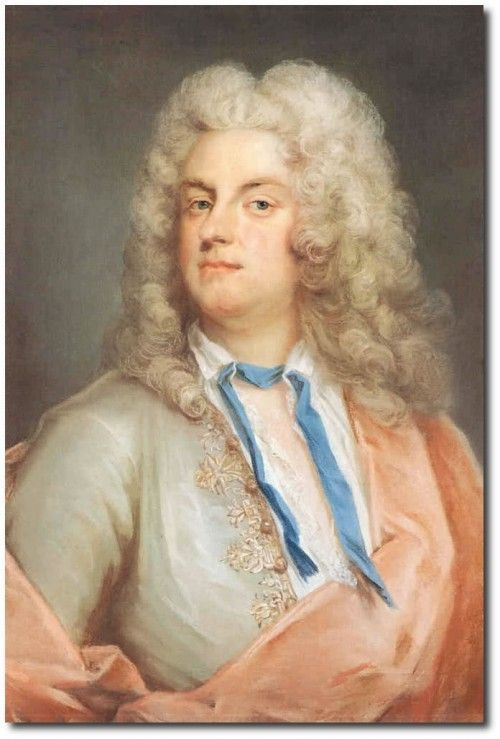
Portrait of Carl Gustaf Tessin, 1728.

Sir Charles Howard, 1738.
I actually made one of these last year!

The collar doesn't sit as well with the ribbon as it does with 2 buttons, but once you put a stock over it it's fine.
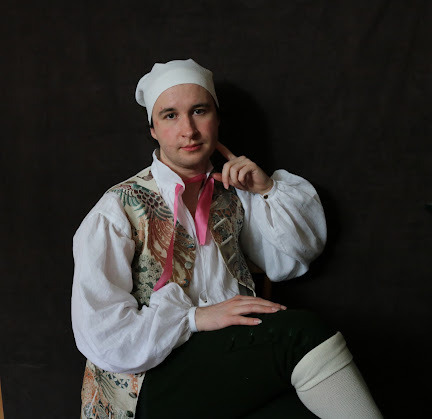

Nearly every single depiction of an 18th century shirt I've ever seen (and I've spent a LOT of time looking) uses sleeve links on the wristbands. (Which I have a tutorial for! They're really easy to make!)
I do sleeve links on most of my everyday shirts because I like them better than sewn on buttons. When the wristband is this narrow, sewn on buttons don't sit very nicely.
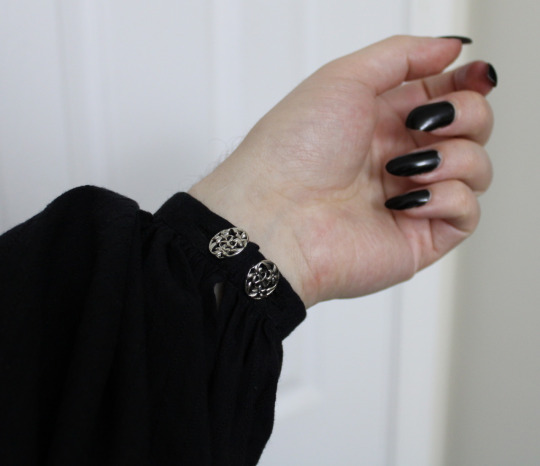
But! If your friend wants ties on the wrist in a historical way, I do know of one single example, and it's this guy!
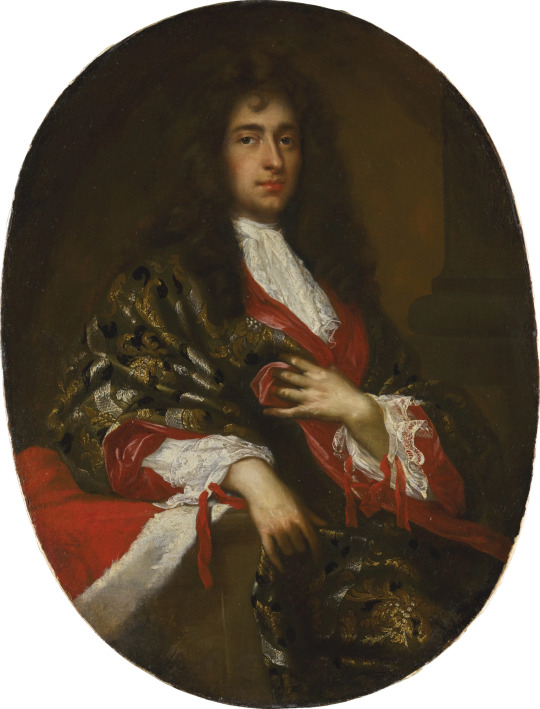

Giovanni Maria delle Piane, Portrait of a nobleman. No date given, but if I had to guess I'd say 1680's or 90's. Very late 17th century looking fellow.
We can't see his collar closure, but I think it's very possible that he has a matching red ribbon holding that closed.
Personally I wouldn't want to try these, because they look like an absolute nightmare to tie by yourself one handed. But the good news is that you could make just regular wristband that take sleeve links and they'd work for this too, since both just have a buttonhole at each end!
I aim for a finished wristband length that's 10-14mm longer than my wrist measurement, with the buttonhole being about 4 or 5mm in from the edge, which gives me enough ease to wear them comfortably with sleeve links, so if you do that then he'll be able to wear them both ways.
287 notes
·
View notes